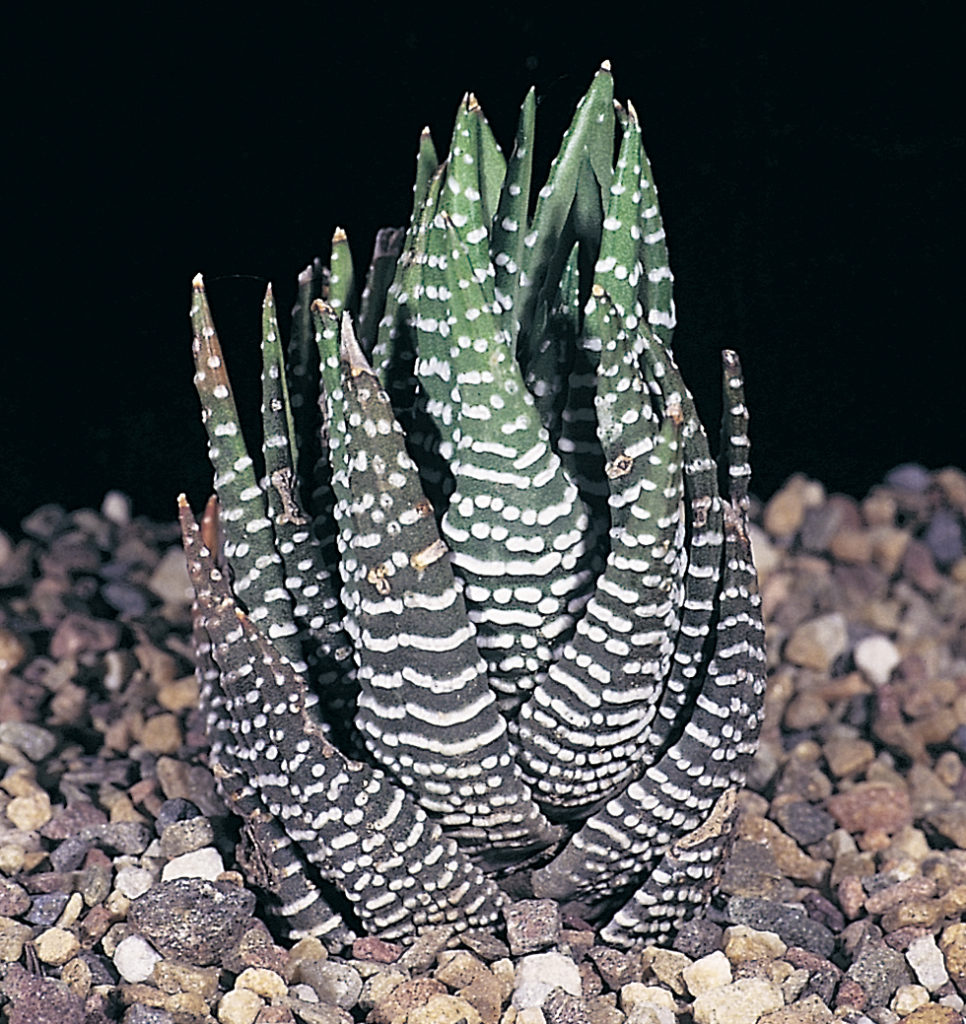45. Haworthia fasciata (Willd.) Haw., Suppl.Pl.Succ. :57(1819) in fort. H. fasciata var. major Haw., Syn.Pl.Succ. :58(1819) Haw., Revis. :54(1821). Baker, JLinn.Soc.Bot. 18:204(1880). Bayer :116(1976). Bayer :66(1982). Scott :20(1985). Apicra fasciata Willd., Ges.Naturf.Fr.Berl.Mag. S:270(1811). Aloe fasciata (Willd.) Salm Dyck, Monogr. 6:f15(1837). Type: None known. Neotype (designated here): icon, f15, Salm Dyck 6(1837). Epitype (ex B&M): Hankey, Stayner (NBG): Aloe fasciata var. major Salm Dyck, Monogr. 6:fl5B(1837). H. fasciata var. major (S.D.) V.Poelln., Feddes Repert.Spec.Nov. 43:95(1938). Type: icon, Salm Dyck 6:f15B(1837): H. fasciata var. subconfluens V.Poelln., Kakteenk. 9:133(1937). H. fasciata fa subconfluens V.Poelln., Feddes Repert.Spec.Nov. 43:95(1938). Type: Cape, Humansdorp, Mrs I. King. Not preserved: H. fasciata fa ovatolanceolata idem 43:96(1938). Type: Cape, Humansdorp, Mrs I. King. Not preserved: H. fasciata fa sparsa ibid. 43:96(1938). Type: Cape, Witteklip near Uitenhage, Long 479. Not preserved: H. fasciata fa variabilis ibid. 43:96(1938). Type: Cape, Elandsriver road, Cook in Long 443. Not preserved: H. fasciata fa vanstaadenensis ibid. 43:97(1938). Type: Cape, Vanstaadens Pass, Long 443. Not preserved: H. browniana V.Poelln., Desert Pl.Life 9:102(1937). V.Poelln., Feddes Repert.Spec.Nov. 44.212(1938). H. fasciata fa browniana (V.Poelln.) Bayer :105(1976). Bayer :66(1982). Scott :21(1985). Type: Cape, Uitenhage, Armstrong. Not preserved. Lectotype (B&M): icon (B).
fasciata: barred.
Rosette to 150mm φ, stemless, proliferating. Leaves 60-80, erect, to 60 X 15mm, incurved, scabrid, white tubercles on underside only. Inflorescence simple or occasionally compound, to 300mm. Flowers tepals fused, tube straight, lower inner tepals revolute.
1982 – H. fasciata occurs in False Sclerophyllous Shrub vegetation around Port Elizabeth and east of the Gamtoos river valley. Unlike H. attenuata and H. radula which have lanceolate leaves with tuberculate leaf faces, in H. fasciata the leaves are more deltoid and the leaf faces smooth. The leaves also tend to curve inwards so that the plants can resemble young stemless rosettes of H. coarctata or H. reinwardtii. The fa browniana occurs as only one small population north of Uitenhage which has been reported to be a vegetatively propagated clone (an interchange heterozygote; Brandham, 1981). This form tends to be caulescent, brownish in colour, and with longer and broader leaves than is usual for the species. H. fasciata is more difficult in cultivation than H. attenuata and this may be because it is far less proliferous and because it occurs in acid soils.
1999 – There is a curious twist in the synonomy of this species because Haworth seemed to have actually been unaware of Wiildenow’s description and applied the same epithet to a plant fortuitously the same. It appears that his species was actually H. reinwardtii and his variety major was synonymous with Willdenow’s species. Somebody else can resolve the synonymy in a better way if they choose. As is also obvious from the synonymy, there is also quite a considerable variation in this species although its distribution is relatively closely confined to the Port Elizabeth area. Plants from east of Uitenhage can be quite heavily tubercled and are more attractive in cultivation than most members of the species. Dr. Hayashi (priv. comm.) refutes the contention that the forma browniana comprises a single clone. Here it is no longer formally upheld as a taxon although it is an obvious variant, because recognition of variants of this kind in a consistent way would result in an excessive proliferation of names. Although the normal distinction from H. attenuata is on the basis of a tubercle-free upper leaf surface, H. fasciata has fibres in the leaf which must constitute a more profound difference between the two species. Fibres are also present in the leaves of H. longiana, H. coarctata and H. glauca and this character may suggest a real division in the subgenus.
Distribution: 3324 (Steytlerville): Moordenaarskloof (-CC), Stayner (NBG); W. Assegaaibos (-CC). Smith 896 (NBG); Witteklip (-CD), Fourcade 124 (NBG); Near Assegaaibos (-CD), Smith 2071 (NBG); Assegaaibos (-CD), Fourcade 2409 (BOL); E. Patensie (-DD), Smith 2907 (NBG); Gamtoos Bridge (‑DD), Stayner in NBG68720, Fourcade 10, 11 (NBG), Smith 5799, 7265a (NBG); Hankey (DD), Fourcade 9 (NBG), Smith 2295 (NBG), Smith 5745 (NBG), Stayner in KG 352/62;; N. Hankey (-DD), Smith 2929, 3693 (NBG); E. Hankey (-DD), Smith 3180, 5797, 7067 (NBG), Stayner (NBG); Hankey to Humansdorp (-DD), Smith 6812 (NBG); W. Gamtoos Bridge (-DD), Smith 5795 (NBG); NE. Zuurbron (-DD), Smith 3670 (NBG), Bayer & Bruyns 6552 (NBG). 3325(Port Elizabeth): Spring Range (-CB), Bayer 886 (NBG); Hillwacht (-CB), Bayer in KG155/73 (NBG); Uitenhage (‑CB), Stayner in NBG68919; Loerie (-CC), Fourcade 8 (NBG), Stayner (NBG); Vanstaadens Pass (-CC), Fourcade 125 (NBG), Smith 5796, 6133 (NBG); 8km W. Thornhill (-CC), Smith 2866, 3179, 3183, 3183a; 8km E. Hankey (-CC), Bayer 887 (NBG); Bulkrivier (-CC), Fourcade 123 (NBG); Thornhill (-CC), Coates (BOL); Despatch (-CD), Marloth 13166 (PRE); W. Uitenhage (-CD), Smith 706 (PRE); Korsten Hill (-DC), Smith 5798 (NBG); Port Elizabeth (-DC), Stayner (NBG); Cotswold (-DC), Branch 365 (NBG); W. Bethelsdorp (-DC), Smith 5821, 5822 (NBG); Baakens Valley (-DC), Cruden 354 (PRE); Korsten Hill (-DC), G.F. Smith 219 (PRE).
Inadequately located: Steytlerville, Compton in NBG1043/47; Nelspoort, Pearson 520; Port Elizabeth, Grey (BOL); Humansdorp, Coates (BOL); Lavis in NBG2694/27 (BOL), Smith 3241 (NBG), Stayner (NBG), Fourcade 105 (NBG).






